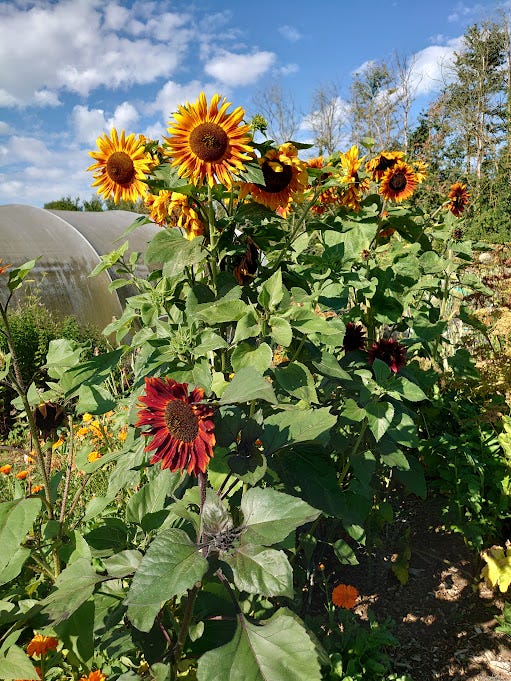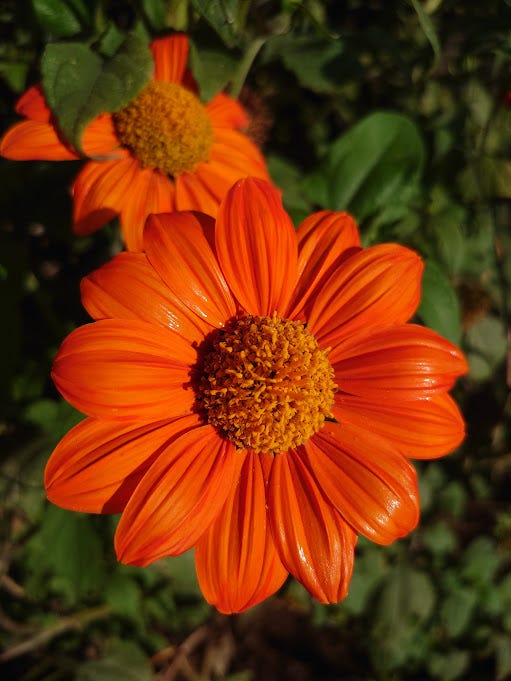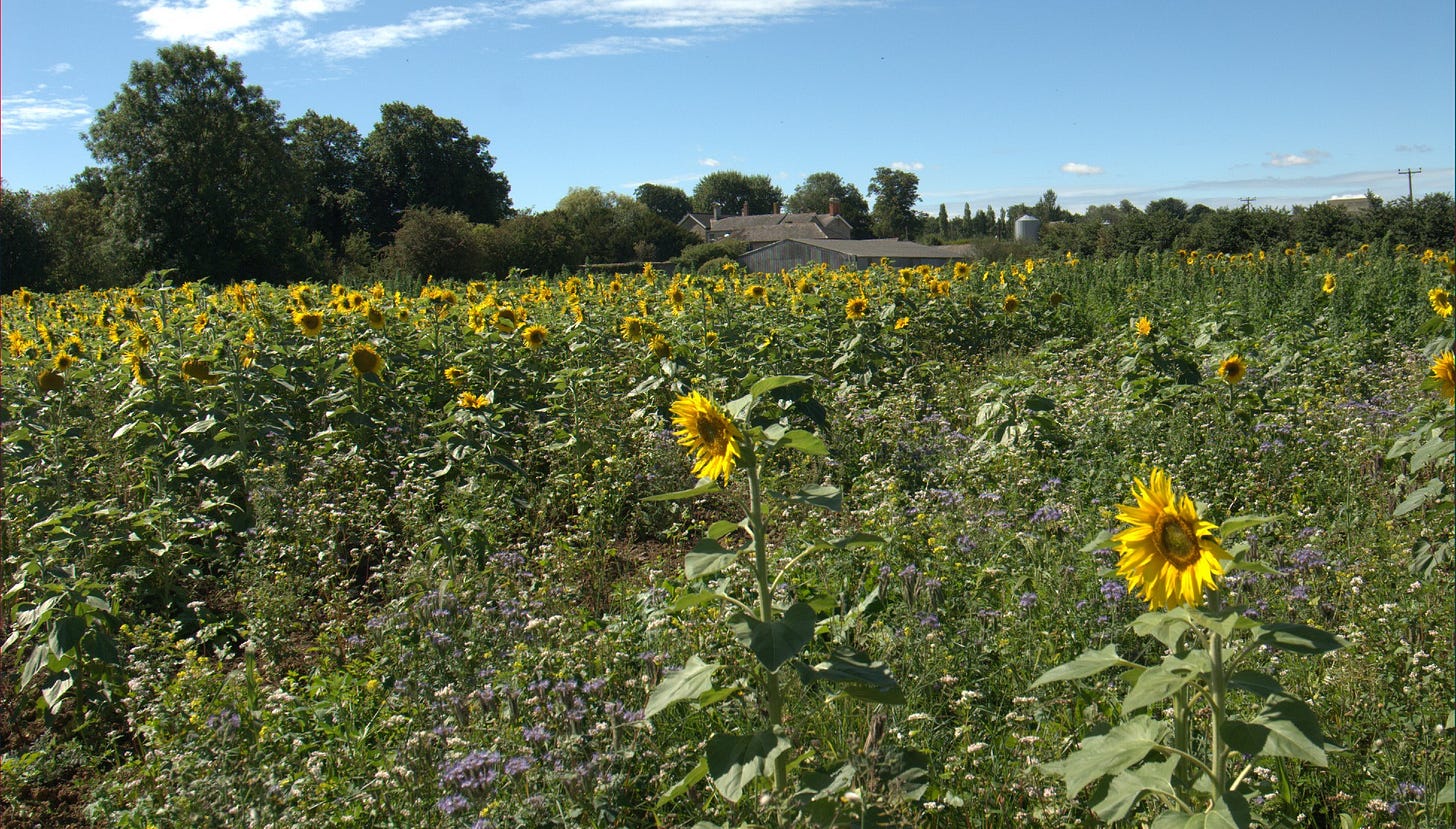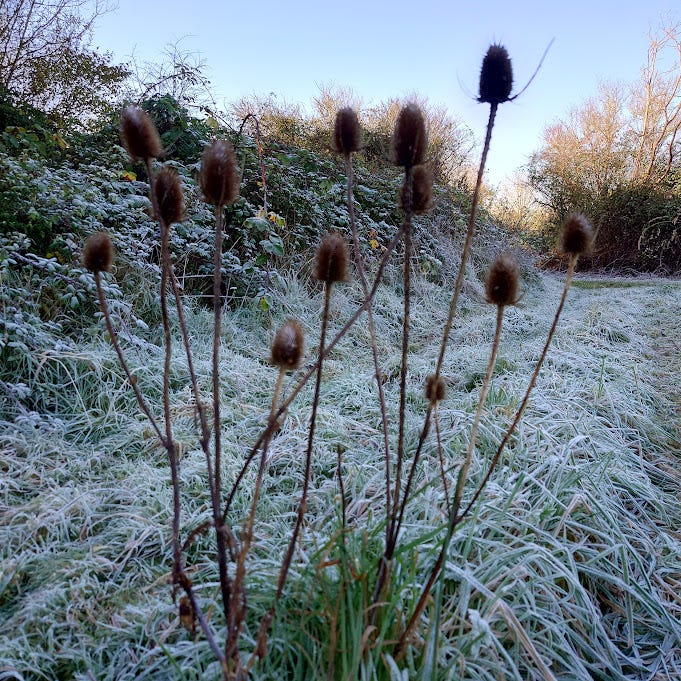Sow now to feed the birds in winter
Sowing annual plants that produce lots of seed is an easy way to provide winter food for seed eating birds, avoiding the need to use bird feeders.
🌱 I'm Sally Morgan, an organic gardener and botanist who loves to experiment. Here you can read about matters relating to climate change, sustainability, organic gardening, growing veg and biodiversity, helping you to become a
climate savvy gardener 🌱☀️🌧️❄️🌡️
Like many gardeners and allotmenteers at this time of year, I am busy sowing, watering and panicking that I am running out of time. May is upon us…. It should be fine, but with the unusually warm weather for this time of year, I’m finding that young seedlings are prone to shrivelling, new transplants need a lot of water, and I’m seeing water stress in some of my herbaceous plants.
This week my focus is on birds and how we can feed them in winter. But first a quick bird update from the farm.
Identifying bird song
I am hopeless at identifying birds by their call. I can do a few, but in recent weeks I have been hearing a new bird by our pond and swampy area. Its call is fairly loud, short, and sharp, and then it flies off and calls again from a different spot.
Fortunately, Melissa Harrison (@witnessmarks) pointed me in the direction of the Merlin bird app that was developed by the Cornell Lab of Ornithology and is powered by eBird. I’ve been having fun with it ever since and it allowed me to finally identify the mystery bird as a Cetti’s warbler.
The Cetti’s warbler (Cettia cetti) is a relatively new addition to the UK bird list, first breeding in Kent in 1972. Its one of those species to be benefitting from climate change, especially our milder winters, and as a result, its numbers have increased almost exponentially. Its range now extends across the south of England and into Wales and Cumbria. So I was really pleased to add this species to the farm list.
Feeding birds in winter
It might seem odd to be thinking about winter when the temperatures are Mediterranean outside, but now is the perfect time to be sowing plants that will provide birds with food in autumn and winter. And I thinking specifically of plants that will feed our seed eaters.
When we first moved to the farm in 20004, finches were common. I recall seeing large numbers of finches of various types feeding on our winter bird mix of sunflower, sweet clover, quinoa, Japanese millet, fodder kale, and buckwheat.
But the numbers of finches have fallen in recent years. Last year, I posted about the problems caused by bird feeders and how they encourage the spread of the disease Trichomonosis amongst finches, causing their population to plummet. This parasitic disease, caused by the protozoan Trichomonas gallinae, has significantly impacted bird populations, especially British greenfinches, whose numbers began declining rapidly in 2006. The greenfinch is now on the UK Red List. Its not just the UK, this disease is affecting species, such as chaffinches, gold finches and even wood pigeons, across Europe and beyond.
The RSPB has issued advice that the classic bird table with a tray is actually helping to spread disease and will not be selling these again. Also, we need to avoid hanging feeders where saliva and faeces can mix with rainwater.
The recommendation is to disinfect weekly with a suitable disinfectant (not soap), but I admit to not cleaning my feeders very often. Now, I only bring out the feeders when the weather is really severe. If you want to know more, you can read an interesting debate about bird feeders here.
I’m concerned about the sustainability of producing large quantities of seed, such as millet and peanuts, to feed birds. I also worry about the potential for habitat loss and the risk that the seed may be contaminated with pesticides.
Rather than relying on commercially grown seed, I decided it would be better to grow more plants that produce lots of seed, instead of supplementing artificially. At the moment, I’m sowing annual species that will be heavy with seed by autumn.
Annual plants to sow for winter seed
I like to take inspiration from some of the agricultural seed catalogues as there are lots of farmers growing wild bird seed mixes and you could seek out the seed in smaller quantities to sow a seed-rich bed in the garden or allotment. Many of my suggestions bring in summer pollinators too, so are of dual benefit.
Here are some ideas, most of which can be grown in Europe and North America
Amaranth (Amaranthus tricolor) - a large, colourful annual producing seeds for finches and sparrows.
Buckwheat (Fagopyrum esculentum) - a fast-growing annual with seeds that are eaten by finches and sparrows. There is a perennial buckwheat (Fagopyrum cymosum) which provides good ground cover but not as much seed.
Cornflower (Centaurea cyanus) - bright blue flowers, seeds eaten by goldfinches and siskins.
Fennel (Foeniculum vulgare) - tall plant with seeds that attract goldfinches if allowed to flower.
Flax (Linum grandiflorum) – there are various options, but the scarlet flax ‘Rubrum’ produces lots of small seeds for finches and sparrows
Mexican sunflower (Tithonia rotundifolia) large plant with bright orange flowers, seeds eaten by goldfinches and sparrows. Great for the back of borders
Millet (Panicum miliaceum) - fast growing, drought-tolerant grass with tiny seeds ideal for sparrows, finches, and buntings.
Mustards (various Brassica and Sinapis species) attract finches and sparrows
Oilseed radish (Raphanus sativus var. oleiformis) - produces seed pods that attract dunnocks, finches, and sparrows.
Phacelia (Phacelia tanacetifolia) – grown mostly for pollinators in summer but seeds will be eaten by finches and sparrows.
Poppy (Papaver rhoeas) - tiny seeds eaten by finches, sparrows, blackbirds, robins, starlings, and wrens in late winter (UK) plus chickadees in USA.
Sunflower (Helianthus annuus) - tall plants with large seed heads and seeds loved by finches, tits, sparrows, starlings, siskins, and wrens (UK) plus cardinals, chickadees, nuthatches and grosbeaks in USA
Zinnia (Zinnia elegans) – colourful flowers, seeds eaten b y finches, sparrows (UK) and cardinals (USA)




And I add one biennial that I don’t think you can be without - the Teasel (Dipsacus fullonum) which is a tall plant with prickly green leaves and bristly flowerhead. The plants stand through winter, not only providing interest but acting as a feeding station for finches and sparrows.
There are many more options so if you have a favourite that I have not mentioned please add it to the comments.
Happy gardening
PS If you enjoyed reading this post, please click the ‘like’ button at the bottom, it really helps make my posts more visible on the SubStack app. Thank you xxx
Talks in 2025
2 May Gardener’s World Spring Festival at Beaulieu, I’m on ‘In Conversation with stage’ with Adam Kirtland at 2.30. Do come and say hello if you are visiting the show
3 May Hotwells & District Allotments Association, Bristol
27 May East Mendip Garden Club at Oakhill
28 May Thruxton Garden Club
5 June Teignmouth Garden Club
10 June Frome Selwood Horticultural Club
1 July Sherston, near Malmesbury
9 July Bramzero, Calne
21 July Bride Valley near Dorchester
1 September Wootton Bassett
2 September Marshfield
4 September Dilton
18-20 September Yeo Valley Organic Garden Festival








Another super useful substack post, thank you so much. I will surely look into those bird food plants and see if we can make a little space for them in our garden.
Wry useful. Happy to say I’ve been sowing some of these already